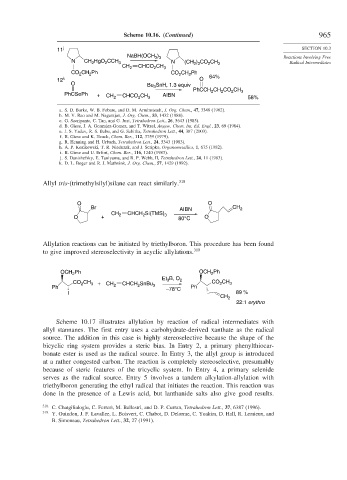Page 989 - Advanced Organic Chemistry Part B - Reactions & Synthesis
P. 989
Scheme 10.16. (Continued) 965
11 j SECTION 10.3
NaBH(OCH ) Reactions Involving Free
3 3
N CH 2 HgO CCH 3 N (CH ) CO CH 3 Radical Intermediates
2
2 3
2
CH 2 CHCO CH 3
2
CO 2 CH 2 Ph CO 2 CH Ph
2
12 k O 64%
O SnH, 1.3 equiv
Bu 3
PhCCH CH CO CH 3
2
2
2
PhCSePh + CH 2 CHCO CH 3 AIBN 58%
2
a. S. D. Burke, W. B. Fobare, and D. M. Arminsteadt, J. Org. Chem., 47, 3348 (1982).
b. M. V. Rao and M. Nagarajan, J. Org. Chem., 53, 1432 (1988).
c. G. Sacripante, C. Tan, and G. Just, Tetrahedron Lett., 26, 5643 (1985).
d. B. Giese, J. A. Gonzalez-Gomez, and T. Witzel, Angew. Chem. Int. Ed. Engl., 23, 69 (1984).
e. J. S. Yadav, R. S. Babu, and G. Sabitha, Tetrahedron Lett., 44, 387 (2003).
f. B. Giese and K. Heuck, Chem. Ber., 112, 3759 (1979).
g. R. Henning and H. Urbach, Tetrahedron Lett., 24, 5343 (1983).
h. A. P. Kozikowski, T. R. Nieduzak, and J. Scripko, Organometallics, 1, 675 (1982).
i. B. Giese and U. Erfort, Chem. Ber., 116, 1240 (1983).
j. S. Danishefsky, E. Taniyama, and R. P. Webb, II, Tetrahedron Lett., 24, 11 (1983).
k. D. L. Boger and R. J. Mathvink, J. Org. Chem., 57, 1429 (1992).
Allyl tris-(trimethylsilyl)silane can react similarly. 318
O O
Br AIBN CH 2
CH 2 CHCH Si(TMS) 3
2
O + 80°C O
Allylation reactions can be initiated by triethylboron. This procedure has been found
to give improved stereoselectivity in acyclic allylations. 319
OCH Ph OCH Ph
2
2
Et B, O 2
3
CO 2 CH 3 + CH 2 CHCH SnBu CO 2 CH 3
Ph 2 3 –78°C Ph
I 89 %
CH 2
22:1 erythro
Scheme 10.17 illustrates allylation by reaction of radical intermediates with
allyl stannanes. The first entry uses a carbohydrate-derived xanthate as the radical
source. The addition in this case is highly stereoselective because the shape of the
bicyclic ring system provides a steric bias. In Entry 2, a primary phenylthiocar-
bonate ester is used as the radical source. In Entry 3, the allyl group is introduced
at a rather congested carbon. The reaction is completely stereoselective, presumably
because of steric features of the tricyclic system. In Entry 4, a primary selenide
serves as the radical source. Entry 5 involves a tandem alkylation-allylation with
triethylboron generating the ethyl radical that initiates the reaction. This reaction was
done in the presence of a Lewis acid, but lanthanide salts also give good results.
318 C. Chatgilialoglu, C. Ferreri, M. Ballestri, and D. P. Curran, Tetrahedron Lett., 37, 6387 (1996).
319
Y. Guindon, J. F. Lavallee, L. Boisvert, C. Chabot, D. Delorme, C. Yoakim, D. Hall, R. Lemieux, and
B. Simoneau, Tetrahedron Lett., 32, 27 (1991).

